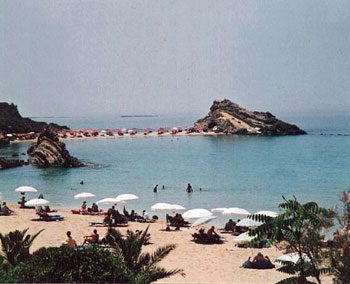
by W. Ruth Kozak
The Ionian Islands of Greece’s west coast, have inspired poets like Homer, Sappho, Cavafy and Lord Byron. The sea here is so transparent you can see straight into the depths. The wind has eroded the shoreline to form sheer cliffs and extraordinary caves where once pirates lurked and often hid their treasures. The pale, platinum clear water, still as enamel one moment, can turn into a raging tempest when the wind shifts.
Kefalonia is the largest and most mountainous of the islands. Its coast forms steep cliffs and small bays with magnificent, wind-protected beaches. Pretty villages of pastel stone houses cluster around the curves of sandy bays. Little coves that used to shelter pirate galleons and Venetian merchant ships are harbors for yachts from all over the world. Resort hotels dot the shoreline, especially near the gold sand beaches of Platia Gialos and Poros.
Kefalonia has often been visited by famous people, most notably the poet Lord Byron, who often came here to enjoy the scenery. In the village of Metaxata, there’s a plaque on the house where he stayed just before he went off to Missolonghi to fight the Turks, and later died of pneumonia.
British author Louis de Bernieres, made the island of Kefalonia famous with his best selling novel “Captain Corelli’s Mandolin”, about a young Italian officer posted to the island as one of the occupying forces during W.W.II.
 As I watched the glorious sunset from the Venetian-style lighthouse, Fenari, I contemplated the many tragedies that have befallen this beautiful island.
As I watched the glorious sunset from the Venetian-style lighthouse, Fenari, I contemplated the many tragedies that have befallen this beautiful island.
In 1953 Kefalonia was devastated by an earthquake, which ruined most of its villages. Almost all the architecture on the island is post-earthquake. The elegant opera house and Venetian-style mansions of Argostoli and Lixouri no longer exist. Here and there on the island lie ruins of destroyed houses, a reminder of the disaster.
At the northern tip of the island is the lovely little town of Fiskardo. It used to be a port of shelter for a Norman pirate named Robert Guiscard, for whom the town is named. On the headland are the ruins of two Venetian lighthouses and a twelfth-century chapel that is believed to have been started by Guiscard.
From Kefalonia, it’s only a short cruise by ferry over to Ithaka, the small island featured in Homer’s “Odyssey” as the kingdom of the extreme adventurer Odysseus.
A brisk breeze ruffled the water as I watched the dark mountains of Ithaka draw near across the narrows. The boat pulled into one of Ithaka’s secret coves. The port is shaped like a horseshoe. In the centre is a tiny island where a charming seaman’s chapel is surrounded by cypresses. Lord Byron, who often visited Ithaka, used to row out to it each morning to swim.
 The harbor of Vathi is surrounded by houses with red-tiled roofs. Cafes animate the waterfront. The summer evening is scented with the smoke of grilling kebabs and fresh-caught fish grilling over charcoal coals. There is a curious atmosphere here. Ithaka’s hillsides are scented with wild sage and oregano, dotted with vibrant wild-flowers and silvery olive groves. Surrounding the tranquil orchards and vineyards are the high menacing mountains.
The harbor of Vathi is surrounded by houses with red-tiled roofs. Cafes animate the waterfront. The summer evening is scented with the smoke of grilling kebabs and fresh-caught fish grilling over charcoal coals. There is a curious atmosphere here. Ithaka’s hillsides are scented with wild sage and oregano, dotted with vibrant wild-flowers and silvery olive groves. Surrounding the tranquil orchards and vineyards are the high menacing mountains.
The main port of Vathi is situated on a pretty bay. Most of the old town was destroyed in the earthquake of 1953 and there are still a few examples of pre-quake architecture.
I visited the Cave of the Nymphs where a team of American archaeologists and students are busy sifting and sorting through rubble brought up from a ten-meter pit. This cave is believed to be the one where Odysseus hid the gifts given to him by the Phaecians when he returned home after his long, arduous voyage. Later, on our way to the town of Stavros, I passed the rock-strewn remains of what is believed to be the Bronze Age city.
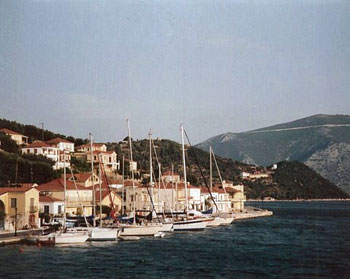 It’s an Odyssey in itself just getting off Ithaka. The taxi picked me up as scheduled in order to make the sailing to Lefkada. I enjoyed the scenic drive and arrive in plenty of time, but fifteen minutes before the ferry was due to arrive, I discovered that the ferry that had broken down, and we must leave from a different port. After a hair-raising wild race by taxi on a twisting road with hairpin curves and precipices, I arrived at the port just minutes before the ferry sailed.
It’s an Odyssey in itself just getting off Ithaka. The taxi picked me up as scheduled in order to make the sailing to Lefkada. I enjoyed the scenic drive and arrive in plenty of time, but fifteen minutes before the ferry was due to arrive, I discovered that the ferry that had broken down, and we must leave from a different port. After a hair-raising wild race by taxi on a twisting road with hairpin curves and precipices, I arrived at the port just minutes before the ferry sailed.
A school of dolphins frolicked in the surf alongside the ferry as we sailed toward the high sandstone cliffs of Lefkada’s south coast. I disembarked at the pleasant little port of Vassiliki, a popular centre for wind-surfers. Hundreds of brightly colored sails skimmed like butterflies over the surface of the Bay. Wind surfers come here from all over Europe.
The next day, I went on a boat cruise around the Cape known as “Sappho’s Leap” where the poet Sappho committed suicide back in 600 BC.
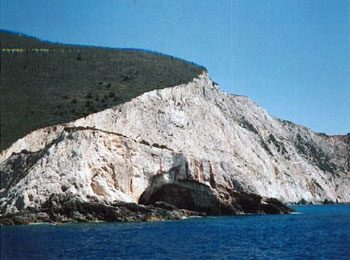 Sailing past Cape Doukas, the towering white cliffs rise from a sea that is as blue as a robin’s egg. The Cape looks like a gigantic wedge of cake with a lighthouse on top for a candle.
Sailing past Cape Doukas, the towering white cliffs rise from a sea that is as blue as a robin’s egg. The Cape looks like a gigantic wedge of cake with a lighthouse on top for a candle.
The boat anchored at idyllic Egremeni Beach and we scrambled down steep ladders to the shore. I had brought a picnic lunch and a book of Sappho’s love poems and lay on the beach listening to the waves crackle on the pebble shore. As I looked up at those high cliffs from where she plunged, I read her haunting words: “About the cool water, the wind sounds through sprays…”
I extended my visit to Lefkada when I saw an advertisement for another excursion. “Islands Panorama” promised to include Onassis’ island, Skorpios, the island of Madouri, home of Greek national poet Valaortes, and Meganissi, an island famous for its sea caves.
Our first stop was the Cave of Papanikolis. The boat navigated carefully around submerged rocks and entered the mysterious blue cavern. I was surprised to see that there was already another boat inside. I imagined the cave as a pirate’s hideaway.
On the way to the next island stop, we chased a school of dolphins around in circles in the Bay. Dolphins are a rare sight because the fishers, who claim they damage their nets, are killing them. But here in the Ionian Sea there seems to be an abundance, and they are a joy to watch as they splash and dive through the boat’s wake.
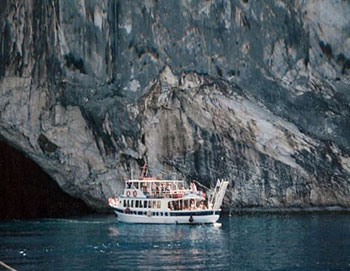 The boat circled the island of Skorpios, a small island, densely wooded with cypress and pine trees. The red-tiled roofs of the Onassis’ villas are half-hidden behind the trees. In each little cover there are piers, each with a palm tree planted at the end. Around the dock areas, the grounds are landscaped and showers of magenta bougainvillea spill over the stone fences. One of these villas was a gift to opera singer Maria Callas in the days before Onassis abandoned her in favor of Jacqueline Kennedy.
The boat circled the island of Skorpios, a small island, densely wooded with cypress and pine trees. The red-tiled roofs of the Onassis’ villas are half-hidden behind the trees. In each little cover there are piers, each with a palm tree planted at the end. Around the dock areas, the grounds are landscaped and showers of magenta bougainvillea spill over the stone fences. One of these villas was a gift to opera singer Maria Callas in the days before Onassis abandoned her in favor of Jacqueline Kennedy.
We were allowed to disembark to swim at a small pebble beach secluded by a thick stand of myrtle bushes. Cicadas trill in the pine trees. As I paddled in the clear, turquoise water, I thought of how not long ago, Jackie O and her children had swam there. So did Maria Callas. And once Princess Diana and her lover Dodi Fayez cruised and frolicked in those same waters.
Skorpios is a symbol of the Rich and Famous, Onassis’ private Garden of Eden. Yet it’s a strange, tragic paradise, with nobody left to enjoy it but Onassis’ granddaughter, Athena, said to be the richest girl in the world.
We cruised away from Skorpios and skirted around the smaller islands, with a stop for a swim at Agiofili Beach. The whole day was a delightful island experience. I not only followed the path of poets and ancient adventurers, I even went swimming where the rich and famous once swam.
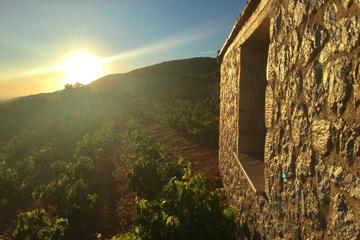
Private Tour: Kefalonia Wine Discovery with Gastronomic or Picnic Lunch
If You Go:
To Kefalonia:
- Buses leave the Kifissou Avenue depot in Athens several times a day for the ports of Sami, Argostoli, Lixouri and Poros, via the ferry from Patras. Trip takes 8 hours. Approx. $35 one way.
- Olympic Airways domestic flights are available as well as charter direct from Britain.
- Hotels and pensions throughout the island accommodate travelers. An island bus provides service to any of the scenic villages and beaches. From Argostoli, take the commuter ferry to Lixouri.
- Car and moped rentals are also available.
- Camp sites are located at Argostoli and Sami.
To Ithaka:
- Ferries run daily from the port of Patras, or neighboring islands Kefalonia and Lefkada.
- Buses run daily from Athens Kifissou Avenue depot, connecting with the ferry at Patras.
- Accommodations are available in private homes and hotels on Ithaka.
- No camping is allowed.
To Lefkada:
- You can reach Lefkada by car or bus as the island is connected to the mainland at the northern point by a bridge.
- Buses run daily from the Athens Kifissou Avenue. Depot.
- If you’re island hopping you can go by ferry from Kefalonia (Fiskardo) or Ithaka to Vassiliki.
- At Vassiliki there is accommodation in pensions, hotels and a campsite is located near the wind-surf beach.
About the author:
Ruth has always enjoyed Homer’s tales of adventure, and this journey, like others she has made to Troy, was a chance to follow Odysseus travels. Ruth is a historical fiction writer, travel journalist, playwright and poet, so visiting these places connected to other writers and poets made this trip extra special. See her website at www.ruthkozak.com
All photographs are by W. Ruth Kozak.



Leave a Reply
You must be logged in to post a comment.